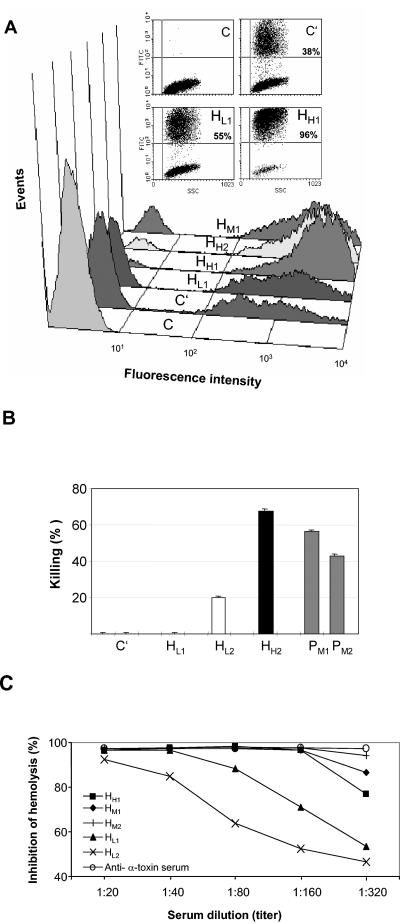FIG. 9.
Antistaphylococcal antibody levels correlate with functionality. (A) A FACS-based opsonophagocytosis assay was performed with fluorescently labeled S. aureus (Wood strain) and P388.D1 mouse macrophage cells in the presence of 10% human sera with different total antistaphylococcal titers. Sera were from low (HL1)-, intermediate (HM1)-, and high (HH1 and HH2)-titer sera, all from healthy (H) donors. C, control (no serum or complement added); C′, only complement (no serum added); HL1, HM1, and HH1 and HH2, 10% serum added in the presence of complement. (B) Levels of bactericidal killing activity of total serum IgG preparations were determined by a plating assay. IgG (1 μg) was preincubated with S. aureus 8325-4 cells before addition to cultured mouse RAW264.7 monocytic cells in the presenceof complement. Low (HL1 and HL2)-, intermediate (PM1 and PM2)-, and high (HH2)-titer sera were from healthy donors (H) or infected patients (P). Bactericidal activity is expressed as the percentage of decrease in CFU levels relative to the results seen with control samples (no IgG). (C) Toxin neutralization activity was measured as the level of hemolysis of rabbit red blood cells by alpha-toxin from S. aureus in the presence of human sera used at 20- to 320-fold dilutions. Low (HL1 and HL2)-, intermediate (HM1 and HM2)-, and high (HH1)-titer sera were from healthy (H) donors. Toxin-neutralizing activity was expressed as a percentage of inhibition of hemolysis by alpha-toxin at different serum dilutions. Hemolysis was measured as a release of hemoglobin that was quantified by spectrophotometric measurements at 545 nm. Rabbit anti-alpha-toxin serum was used as a positive control in the assay.

